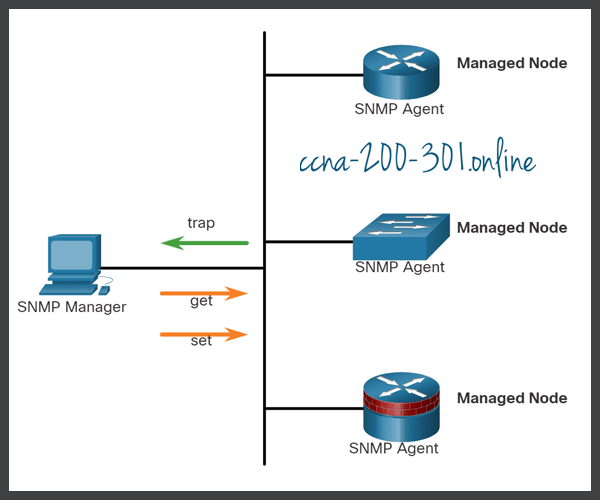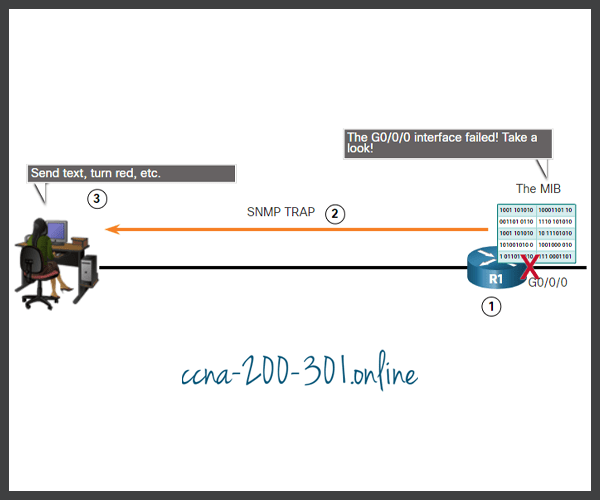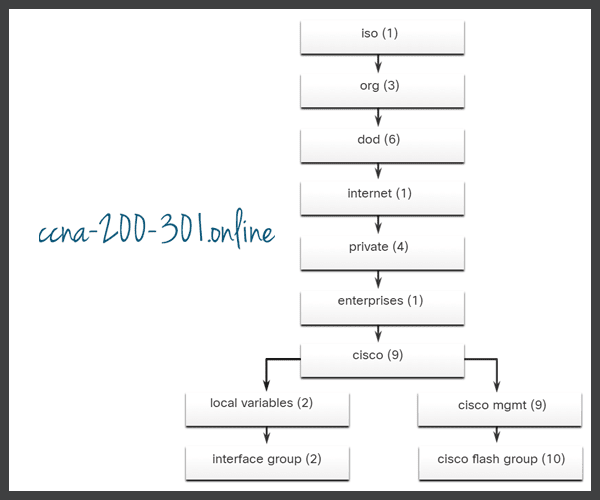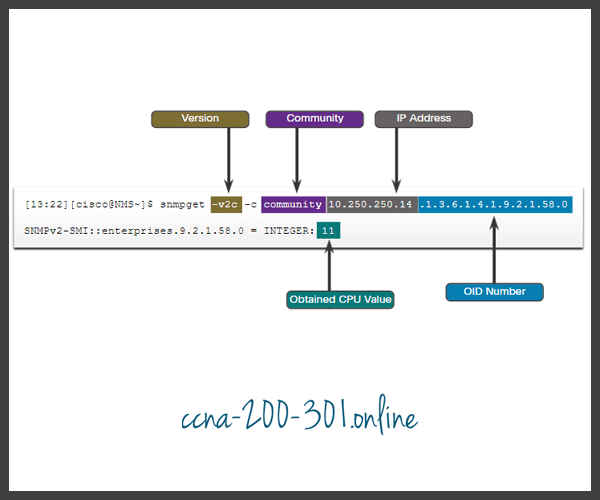SNMP
Summary
This topic explain how SNMP operates. Start learning CCNA 200-301 for free right now!!
Table of Contents
Introduction to SNMP
Now that your network is mapped and all of your components are using the same clock, it is time to look at how you can manage your network by using Simple Network Management Protocol (SNMP).
SNMP was developed to allow administrators to manage nodes such as servers, workstations, routers, switches, and security appliances, on an IP network. It enables network administrators to monitor and manage network performance, find and solve network problems, and plan for network growth.
SNMP is an application layer protocol that provides a message format for communication between managers and agents. The SNMP system consists of three elements:
- SNMP manager
- SNMP agents (managed node)
- Management Information Base (MIB)
To configure SNMP on a networking device, it is first necessary to define the relationship between the manager and the agent.
The SNMP manager is part of a network management system (NMS). The SNMP manager runs SNMP management software. As shown in the figure, the SNMP manager can collect information from an SNMP agent by using the “get” action and can change configurations on an agent by using the “set” action. In addition, SNMP agents can forward information directly to a network manager by using “traps”.

The SNMP agent and MIB reside on SNMP client devices. Network devices that must be managed, such as switches, routers, servers, firewalls, and workstations, are equipped with an SNMP agent software module. MIBs store data about the device and operational statistics and are meant to be available to authenticated remote users. The SNMP agent is responsible for providing access to the local MIB.
SNMP defines how management information is exchanged between network management applications and management agents. The SNMP manager polls the agents and queries the MIB for SNMP agents on UDP port 161. SNMP agents send any SNMP traps to the SNMP manager on UDP port 162.
SNMP Operation
SNMP agents that reside on managed devices collect and store information about the device and its operation. This information is stored by the agent locally in the MIB. The SNMP manager then uses the SNMP agent to access information within the MIB.
There are two primary SNMP manager requests, get and set. A get request is used by the NMS to query the device for data. A set request is used by the NMS to change configuration variables in the agent device. A set request can also initiate actions within a device. For example, a set can cause a router to reboot, send a configuration file, or receive a configuration file. The SNMP manager uses the get and set actions to perform the operations described in the table.
| Operation | Description |
|---|---|
get-request |
Retrieves a value from a specific variable. |
get-next-request |
Retrieves a value from a variable within a table; the SNMP manager does not need to know the exact variable name. A sequential search is performed to find the needed variable from within a table. |
get-bulk-request |
Retrieves large blocks of data, such as multiple rows in a table, that would otherwise require the transmission of many small blocks of data. (Only works with SNMPv2 or later.) |
get-response |
Replies to a get-request, get-next-request, and set-request sent by an NMS. |
set-request |
Stores a value in a specific variable. |
The SNMP agent responds to SNMP manager requests as follows:
- Get an MIB variable – The SNMP agent performs this function in response to a GetRequest-PDU from the network manager. The agent retrieves the value of the requested MIB variable and responds to the network manager with that value.
- Set an MIB variable – The SNMP agent performs this function in response to a SetRequest-PDU from the network manager. The SNMP agent changes the value of the MIB variable to the value specified by the network manager. An SNMP agent reply to a set request includes the new settings in the device.
The figure illustrates the use of an SNMP GetRequest to determine if interface G0/0/0 is up/up.

SNMP Agent Traps
An NMS periodically polls the SNMP agents that are residing on managed devices using the get request. The NMS queries the device for data. Using this process, a network management application can collect information to monitor traffic loads and to verify the device configurations of managed devices. The information can be displayed via a GUI on the NMS. Averages, minimums, or maximums can be calculated. The data can be graphed, or thresholds can be set to trigger a notification process when the thresholds are exceeded. For example, an NMS can monitor CPU utilization of a Cisco router. The SNMP manager samples the value periodically and presents this information in a graph for the network administrator to use in creating a baseline, creating a report, or viewing real time information.
Periodic SNMP polling does have disadvantages. First, there is a delay between the time that an event occurs and the time that it is noticed (via polling) by the NMS. Second, there is a trade-off between polling frequency and bandwidth usage.
To mitigate these disadvantages, it is possible for SNMP agents to generate and send traps to inform the NMS immediately of certain events. Traps are unsolicited messages alerting the SNMP manager to a condition or event on the network. Examples of trap conditions include, but are not limited to, improper user authentication, restarts, link status (up or down), MAC address tracking, closing of a TCP connection, loss of connection to a neighbor, or other significant events. Trap-directed notifications reduce network and agent resources by eliminating the need for some of SNMP polling requests.
The figure illustrates the use of an SNMP trap to alert the network administrator that interface G0/0/0 has failed. The NMS software can send the network administrator a text message, pop up a window on the NMS software, or turn the router icon red in the NMS GUI.

The exchange of all SNMP messages is illustrated in the figure.

SNMP Versions
There are several versions of SNMP:
- SNMPv1 – This is the Simple Network Management Protocol, a Full Internet Standard, that is defined in RFC 1157.
- SNMPv2c – This is defined in RFCs 1901 to 1908. It uses a community-string-based Administrative Framework.
- SNMPv3 – This is an interoperable standards-based protocol originally defined in RFCs 2273 to 2275. It provides secure access to devices by authenticating and encrypting packets over the network. It includes these security features: message integrity to ensure that a packet was not tampered with in transit, authentication to determine that the message is from a valid source, and encryption to prevent the contents of a message from being read by an unauthorized source.
All versions use SNMP managers, agents, and MIBs. Cisco IOS software supports the above three versions. Version 1 is a legacy solution and is not often encountered in networks today; therefore, this course focuses on versions 2c and 3.
Both SNMPv1 and SNMPv2c use a community-based form of security. The community of managers that is able to access the MIB of the agent is defined by a community string.
Unlike SNMPv1, SNMPv2c includes a bulk retrieval mechanism and more detailed error message reporting to management stations. The bulk retrieval mechanism retrieves tables and large quantities of information, minimizing the number of round-trips required. The SNMPv2c improved error-handling includes expanded error codes that distinguish different kinds of error conditions. These conditions are reported through a single error code in SNMPv1. Error return codes in SNMPv2c include the error type.
SNMPv3 provides for both security models and security levels. A security model is an authentication strategy set up for a user and the group within which the user resides. A security level is the permitted level of security within a security model. A combination of the security level and the security model determine which security mechanism is used when handling an SNMP packet. Available security models are SNMPv1, SNMPv2c, and SNMPv3.
The table identifies the characteristics of the different combinations of security models and levels.
A network administrator must configure the SNMP agent to use the SNMP version supported by the management station. Because an agent can communicate with multiple SNMP managers, it is possible to configure the software to support communications by using SNMPv1, SNMPv2c, or SNMPv3.
Community Strings
For SNMP to operate, the NMS must have access to the MIB. To ensure that access requests are valid, some form of authentication must be in place.
SNMPv1 and SNMPv2c use community strings that control access to the MIB. Community strings are plaintext passwords. SNMP community strings authenticate access to MIB objects.
There are two types of community strings:
- Read-only (ro) – This type provides access to the MIB variables, but does not allow these variables to be changed, only read. Because security is minimal in version 2c, many organizations use SNMPv2c in read-only mode.
- Read-write (rw) – This type provides read and write access to all objects in the MIB.
To view or set MIB variables, the user must specify the appropriate community string for read or write access.
Click Play to see an animation about how SNMP operates with the community string.

MIB Object ID

The MIB organizes variables hierarchically. MIB variables enable the management software to monitor and control the network device. Formally, the MIB defines each variable as an object ID (OID). OIDs uniquely identify managed objects in the MIB hierarchy. The MIB organizes the OIDs based on RFC standards into a hierarchy of OIDs, usually shown as a tree.
The MIB tree for any given device includes some branches with variables common to many networking devices and some branches with variables specific to that device or vendor.
RFCs define some common public variables. Most devices implement these MIB variables. In addition, networking equipment vendors, like Cisco, can define their own private branches of the tree to accommodate new variables specific to their devices.
The figure shows portions of the MIB structure defined by Cisco. Note how the OID can be described in words or numbers to help locate a particular variable in the tree. OIDs belonging to Cisco, are numbered as follows: .iso (1).org (3).dod (6).internet (1).private (4).enterprises (1).cisco (9). Therefore, the OID is 1.3.6.1.4.1.9.
SNMP Polling Scenario
SNMP can be used is to observe CPU utilization over a period of time by polling devices. CPU statistics can then be compiled on the NMS and graphed. This creates a baseline for the network administrator. Threshold values can then be set relative to this baseline. When CPU utilization exceeds this threshold, notifications are sent. The figure illustrates 5-minute samples of router CPU utilization over the period of a few weeks.

The data is retrieved via the snmpget utility, issued on the NMS. Using the snmpget utility, you can manually retrieve real-time data, or have the NMS run a report. This report would give you a period of time that you could use the data to get the average. The snmpget utility requires that the SNMP version, the correct community, the IP address of the network device to query, and the OID number are set. The figure demonstrates the use of the freeware snmpget utility, which allows quick retrieval of information from the MIB.

The snmpget utility command has several parameters, including:
- -v2c – This is the version of SNMP.
- -c community – This is the SNMP password, called a community string.
- 10.250.250.14 – This is the IP address of the monitored device.
- 1.3.6.1.4.1.9.2.1.58.0 – This is the OID of MIB variable.
The last line shows the response. The output shows a shortened version of the MIB variable. It then lists the actual value in the MIB location. In this case, the 5-minute moving average of the CPU busy percentage is 11 percent.
SNMP Object Navigator
The snmpget utility gives some insight into the basic mechanics of how SNMP works. However, working with long MIB variable names like 1.3.6.1.4.1.9.2.1.58.0 can be problematic for the average user. More commonly, the network operations staff uses a network management product with an easy-to-use GUI, which makes the entire MIB data variable naming transparent to the user.
Search for “Cisco SNMP Object Navigator tool” to find the Cisco tool that allows a network administrator to research details about a particular OID. The figure displays an example of using the navigator to research the OID information for the whyReload object.

Lab – Research Network Monitoring Software
In this lab, you will complete the following objectives:
- Part 1: Survey Your Understanding of Network Monitoring
- Part 2: Research Network Monitoring Tools
- Part 3: Select a Network Monitoring Tool
Ready to go! Keep visiting our networking course blog, give Like to our fanpage; and you will find more tools and concepts that will make you a networking professional.





